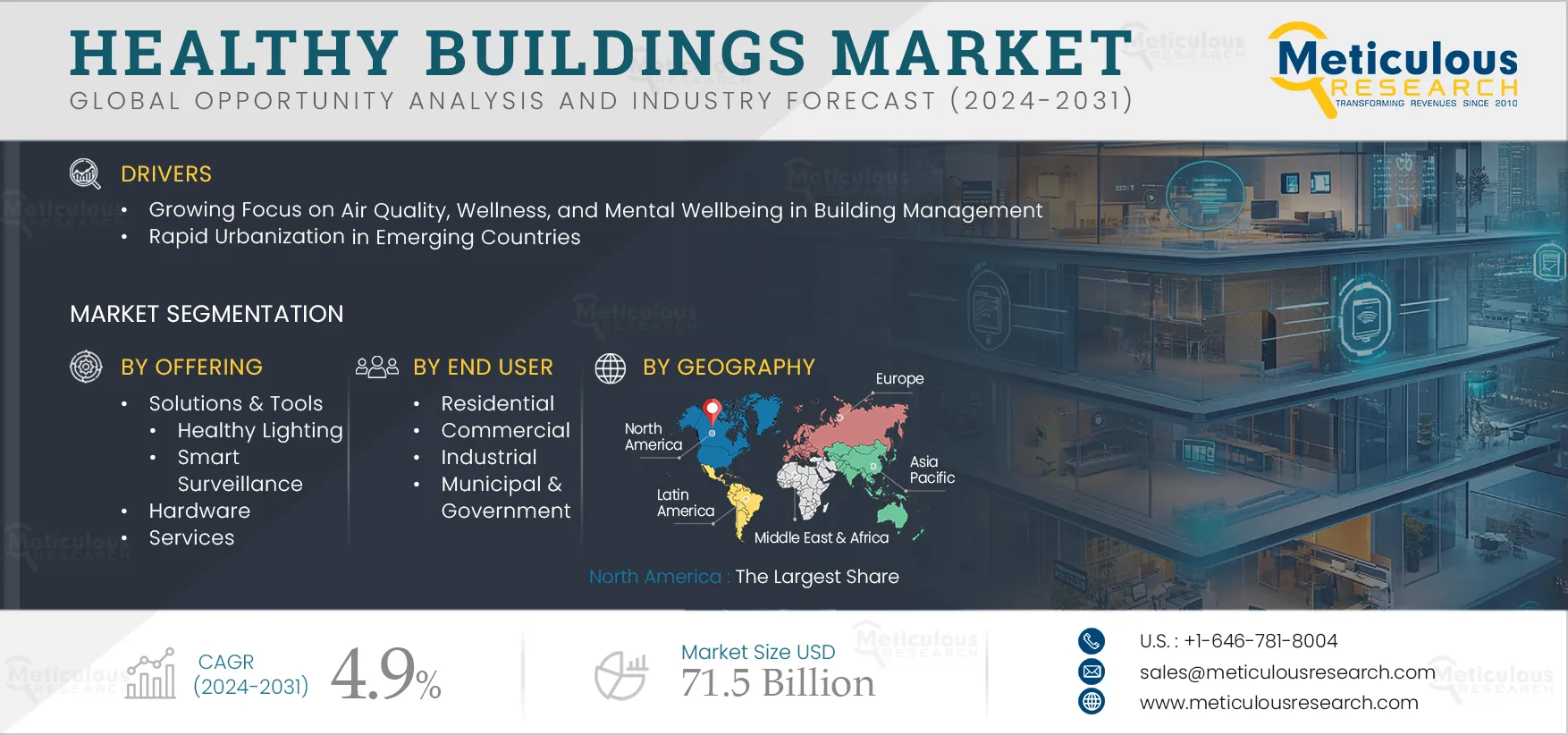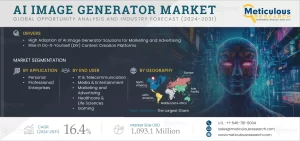
The Healthy Buildings Market was valued at $48.4 billion in 2023. This market is expected to reach $71.5 billion by 2031 from an estimated $51 billion in 2024, at a CAGR of 4.9% during the forecast period from 2024 to 2031.
The Healthy Buildings Market has emerged as a critical sector within the broader construction and real estate industries, with a current valuation of $48.4 billion in 2023. Projections indicate robust growth, with the market expected to reach $71.5 billion by 2031. This growth trajectory reflects an anticipated compound annual growth rate (CAGR) of 4.9% from 2024 to 2031. Several factors contribute to this expansion, including rising awareness of indoor air quality (IAQ), wellness, and mental wellbeing, alongside rapid urbanization in emerging economies.
Download Sample Report Here @ https://www.meticulousresearch.com/download-sample-report/cp_id=6010
Market Growth Drivers
1. Emphasis on Indoor Air Quality and Wellness
In recent years, there has been a significant shift in focus toward the importance of indoor air quality and overall wellness in building management. As the public becomes increasingly aware of the health implications of indoor environments, the construction industry is responding by adopting innovative solutions. Building owners and operators are enhancing ventilation systems and incorporating advanced technologies designed to reduce indoor contaminants.
For instance, many companies are integrating high-efficiency particulate air (HEPA) filters and UV light systems to eliminate airborne pathogens and allergens, significantly contributing to cleaner air. The incorporation of plants, green walls, and natural materials within building designs further fosters environments conducive to relaxation, focus, and overall wellbeing.
Technological Innovations in Indoor Air Quality
To address growing concerns regarding air quality, numerous organizations are introducing smart sensors to monitor environmental conditions. These devices allow for real-time adjustments in factors such as temperature and lighting, thereby enhancing both air quality and the mental health of occupants. A notable example is the Indoor Air Quality (IAQ) monitor launched by Honeywell International Inc. in February 2022. This device alerts building operators to potential air quality issues, enabling proactive measures that mitigate the risk of airborne contaminants.
2. Demand for Green Building Certifications
The construction sector is increasingly seeking green building certifications, which are instrumental in promoting sustainability and health-focused building practices. These certifications are essential for compliance with rigorous energy efficiency standards, ultimately reducing carbon emissions and supporting climate change mitigation efforts.
Certifications that emphasize ventilation, air filtration, and the use of low-VOC materials play a pivotal role in enhancing indoor air quality and occupant wellbeing. As a result, construction firms are prioritizing the health of their customers and the environment, accelerating the adoption of healthy building solutions.
3. Government Incentives for Sustainable Practices
Governments worldwide are recognizing the importance of healthy buildings and are offering various incentives to promote green practices. These include tax breaks, grants, and expedited permitting processes designed to encourage construction companies to pursue green building certifications. By reducing costs and accelerating the adoption of sustainable practices, these incentives play a critical role in fostering a healthier built environment.
Get Insightful Data On Regions, Market Segments, Customer Landscape, And Top Companies (Charts, Tables, Figures And More) :- https://www.meticulousresearch.com/request-sample-report/cp_id=6010
Current Trends Shaping the Healthy Buildings Market
1. Integration of Technology and Smart Systems
The integration of IoT and AI in building management systems is transforming the landscape of healthy buildings. These technologies enable real-time monitoring and control of various building systems, enhancing operational efficiency and occupant comfort. Smart building solutions can regulate temperature, humidity, and lighting, contributing to a healthier indoor environment.
2. The Rise of Green City Initiatives
The global shift towards sustainable and smart buildings is gaining momentum, driven by urbanization and the need for improved environmental stewardship. Green city initiatives focus on creating urban spaces that prioritize health and wellbeing, leading to the incorporation of healthy building solutions that enhance air and water quality, and overall occupant experience.
3. Emphasis on Patient-Centered Design
In healthcare facilities, there is a growing emphasis on patient-centered design, which prioritizes the comfort and wellbeing of patients and staff alike. The integration of healthy lighting, optimized thermal comfort systems, and innovative care management solutions is becoming standard practice in modern healthcare design. This trend not only improves patient outcomes but also enhances the overall experience within healthcare environments.
Market Analysis: Key Findings
Segmentation Overview
The Healthy Buildings Market can be segmented based on various factors, including offerings, end-users, and geographical regions.
Offering Segmentation
The market is divided into three primary segments:
- Solutions & Tools: Expected to dominate the market in 2024, this segment is driven by the adoption of advanced HVAC systems and air purification technologies aimed at ensuring clean indoor air. The integration of smart climate control systems also contributes significantly to market growth.
- Hardware: This segment encompasses various physical systems and devices essential for maintaining healthy building environments.
- Services: Although this segment currently holds a smaller market share, it is projected to register a higher CAGR during the forecast period. This growth is fueled by the increasing demand for services that monitor and regulate indoor environmental conditions.
End-User Segmentation
The Healthy Buildings Market can also be categorized by end-users:
- Residential: While important, the residential segment currently accounts for a smaller share compared to commercial spaces.
- Commercial: This segment is expected to dominate the market, driven by the increasing adoption of healthy building solutions aimed at improving health outcomes and workforce productivity.
- Healthcare Facilities: The demand for patient-centered design in healthcare is rapidly growing, leading to innovative building practices that prioritize occupant wellbeing.
- Industrial: The industrial segment is also recognizing the benefits of healthy building practices, particularly in employee safety and productivity.
Geographical Analysis
North America is projected to dominate the healthy buildings market in 2024, accounting for over 38% of the global share. This dominance is attributed to the region’s commitment to creating healthier work environments and integrating advanced technologies into building management systems.
In contrast, the Asia-Pacific region is anticipated to register the highest CAGR during the forecast period, fueled by increasing investments in green and sustainable building initiatives. Countries in this region are rapidly incorporating health-focused features into office spaces, including natural lighting and air quality management systems.
Have specific research needs? Request a customized research report- https://www.meticulousresearch.com/request-sample-report/cp_id=6010
Key Players in the Healthy Buildings Market
The competitive landscape of the Healthy Buildings Market is characterized by a diverse range of players, each contributing to the advancement of healthy building solutions. Key companies include:
- Honeywell International Inc. (U.S.)
- DAIKIN Airconditioning (Singapore) Pte Ltd.
- Johnson Controls International plc (Ireland)
- Schneider Electric SE (France)
- Siemens Corporation (Germany)
- Bosch Sicherheitssysteme GmbH (Germany)
- Delta Electronics, Inc. (Taiwan)
- Automated Logic Corporation (U.S.)
- Buildings IOT (U.S.)
- UL Solutions Inc. (U.S.)
- 9 Foundations, Inc. (U.S.)
- Allegion Plc. (Ireland)
- Kaiterra (Switzerland)
- BuildingLogiX (U.S.)
Recent Developments
Key industry players are continuously innovating to meet the demands of the healthy buildings market. For example:
- R-Zero Systems launched a RESET-certified indoor air quality monitor in August 2024, providing real-time data visualization and insights on IAQ. This system supports HVAC fault detection and energy optimization, enhancing overall building performance.
- Honeywell International Inc. introduced its Healthy Building Services program in January 2023, aimed at assisting building owners in improving indoor environmental quality and occupant well-being.
Immediate Delivery Available | BUY THIS RESEARCH REPORT (Insights, Charts, Tables, Figures and More) – https://www.meticulousresearch.com/Checkout/26807260
Scope of the Report:
By Offering
- Solutions & Tools
- Indoor Air Quality (IAQ)
- Surface Contamination
- Healthy Lighting
- Smart Care Management
- Smart Surveillance
- Water Quality Management
- Safety and Security Management
- Thermal Comfort Systems
- Building Management Systems
- Other Solutions
- Hardware
- Services
By End User
- Residential
- Commercial
- Office Buildings
- Airports
- Fitness Centre
- Malls & Cinemas
- Hotels & Hospitality
- Sports & Entertainment
- Healthcare Facilities
- Educational Institutions
- Retail Stores
- Industrial
- Municipal & Government
Related Reports:-
Building Automation Market – Global Opportunity Analysis and Industry Forecast (2024-2031)
Smart Building Market – Global Opportunity Analysis And Industry Forecast (2022-2029)
Asia-Pacific Smart Cities Market – Opportunity Analysis and Industry Forecast (2024-2030)
3D Printing Construction Market – Global Opportunity Analysis And Industry Forecast (2024-2030)
Europe Smart Cities Market – Opportunity Analysis and Industry Forecast (2024-2030)






